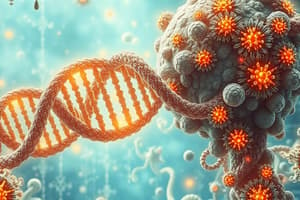Podcast
Questions and Answers
What does the transformation principle demonstrate in Griffith's experiments?
What does the transformation principle demonstrate in Griffith's experiments?
- Dead bacteria can transform live non-virulent bacteria into virulent forms. (correct)
- Bacteria can mate to exchange genetic information.
- Live bacteria can become virulent by absorbing nutrients.
- Virulent bacteria can never change due to environmental conditions.
How did Frederick Griffith's experiments with the S strain and R strain differ?
How did Frederick Griffith's experiments with the S strain and R strain differ?
- S strain is smooth and virulent; R strain is rough and non-virulent. (correct)
- Both strains are smooth, but one is virulent and the other is not.
- R strain is smooth and virulent, while S strain is rough and non-virulent.
- S strain is rough and non-virulent, while R strain is smooth and virulent.
What was the main contribution of Beadle and Tatum's research?
What was the main contribution of Beadle and Tatum's research?
- Development of the concept of genetic drift.
- Discovery that bacteria contain plasmids.
- Proposal of the ‘one gene-one enzyme’ hypothesis. (correct)
- The identification of RNA as the genetic material.
What conclusion did Avery, MacLeod, and McCarty reach about genetic material?
What conclusion did Avery, MacLeod, and McCarty reach about genetic material?
What was the significance of the Hershey and Chase experiment?
What was the significance of the Hershey and Chase experiment?
What discovery is attributed to James Watson and Francis Crick?
What discovery is attributed to James Watson and Francis Crick?
Which of the following statements correctly differentiates DNA from RNA?
Which of the following statements correctly differentiates DNA from RNA?
How can phenotype be influenced by environmental factors?
How can phenotype be influenced by environmental factors?
What structure helps condense DNA in bacteria?
What structure helps condense DNA in bacteria?
What is a plasmid associated with in bacteria?
What is a plasmid associated with in bacteria?
Flashcards are hidden until you start studying
Study Notes
Frederick Griffith's Experiment
- Demonstrated the "transformation principle", a process where dead bacteria can transfer genetic material to live bacteria, altering their characteristics.
- Used two strains of Streptococcus pneumoniae:
- S strain: Smooth, virulent, and causes pneumonia.
- R strain: Rough, non-virulent, and does not cause pneumonia.
- Griffith's experiment showed that heat-killed S strain bacteria could transform live R strain bacteria into virulent S strain bacteria when injected into mice.
The Difference between S and R Strains
- S strain: Smooth, virulent, and has a polysaccharide capsule that protects it from the host's immune system.
- R strain: Rough, non-virulent, and lacks the capsule, making it susceptible to the host's immune system.
Beadle and Tatum's One Gene-One Enzyme Hypothesis
- Proposed that each gene controls the production of a specific enzyme.
- Used the mold Neurospora crassa to study the role of genes in metabolic pathways.
- They demonstrated that each mutation in the mold affected a specific metabolic pathway, supporting their hypothesis.
Avery, MacLeod, and McCarty's Key Finding
- Confirmed that DNA, not protein, is the genetic material responsible for the transformation observed by Griffith.
- Their experiments built upon Griffith's work by isolating and purifying different components of the heat-killed S strain bacteria.
- They found that only DNA was able to transform the R strain into the S strain, proving its role as the genetic material.
Hershey and Chase Experiment: Confirming DNA as the Genetic Material
- Utilized bacteriophages (viruses that infect bacteria) and radioactive labeling to further confirm DNA as the genetic material.
- They labeled the DNA of the bacteriophage with radioactive phosphorus and the protein coat with radioactive sulfur.
- Upon infection, they found that only the radioactive phosphorus (DNA) was transferred to the bacteria, indicating that DNA is the material responsible for carrying genetic information.
Watson and Crick's Discovery
- Determined the double helix structure of DNA.
- Their model explained how DNA replicates and how genetic information is encoded.
Key Differences between DNA and RNA
- DNA is double-stranded, contains deoxyribose sugar, and uses thymine as a base.
- RNA is single-stranded, contains ribose sugar, and uses uracil as a base.
Definitions
- Genome: The complete set of genetic material in an organism.
- Gene: A segment of DNA that codes for a specific protein.
- Phenotype: The observable traits of an organism, influenced by its genotype and environment.
- Genotype: The genetic makeup of an organism.
The Impact of Environment on Phenotype
- Phenotype can be influenced by environmental factors.
- Examples:
- Temperature can affect fur color in animals.
- Light availability can affect plant growth and development.
DNA Organization in Bacteria
- Bacterial DNA is organized within the nucleoid region, a region within the cytoplasm.
- To fit inside the cell, DNA is supercoiled into loop domains, forming a compact structure.
Plasmids
- Small, circular pieces of DNA found in bacteria, separate from their main chromosome.
- Often carry genes that provide advantages, such as:
- Antibiotic resistance.
- Virulence factors.
Studying That Suits You
Use AI to generate personalized quizzes and flashcards to suit your learning preferences.




